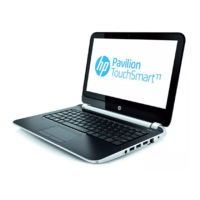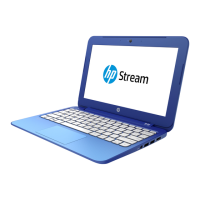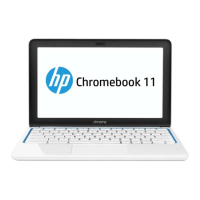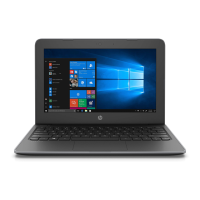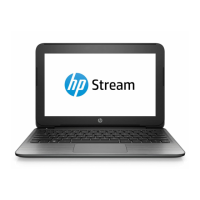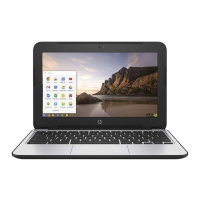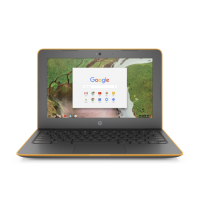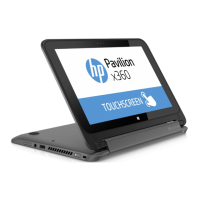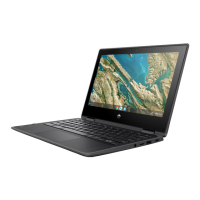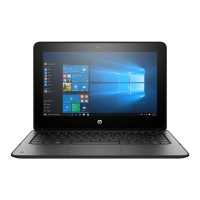
Do you have a question about the HP Fortis 11 G10 Chromebook and is the answer not in the manual?
| Display | 11.6-inch HD (1366 x 768) Anti-glare |
|---|---|
| RAM | 4 GB or 8 GB LPDDR4x |
| Storage | 32 GB eMMC or 64 GB eMMC |
| Operating System | Chrome OS |
| Battery Life | Up to 12 hours |
| Graphics | Intel UHD Graphics |
| Wireless | Wi-Fi 6 (802.11ax) |
| Camera | 720p HD camera |
| Durability | MIL-STD-810H certified |
| Processor | Intel Celeron N4500 |
| Ports | 1 x headphone/microphone combo |
| Keyboard | Full-size, spill-resistant keyboard |
Information about common features and accessing latest guides.
Terms of HP End User License Agreement (EULA) and refund policy.
Precautions to reduce heat-related injuries and overheating.
Detailed list of computer components and their specifications.
Identifies and describes components on the right side of the computer.
Identifies and describes components on the left side of the computer.
Identifies and describes components related to the display assembly.
Information about the keyboard layout and variations.
Details about the touchpad and its functions.
Identifies and explains the function of special keys on the keyboard.
Identifies and describes components located on the bottom of the computer.
Describes the location and purpose of various computer labels.
Illustrates and lists major internal components with part numbers.
Details subcomponents of the display assembly and their part numbers.
Lists various miscellaneous parts and their corresponding part numbers.
Lists the necessary tools for disassembly and reassembly.
General advice and precautions for disassembly and assembly.
Explains the risks of ESD and how it affects components.
Guidelines on how static electricity is generated.
Precautions to prevent damage from static electricity.
Describes methods and equipment for grounding.
Precautions for setting up a static-safe work environment.
Lists recommended materials for preventing static electricity.
How to use software to disable input during cleaning.
Recommended steps for cleaning external computer surfaces.
Steps for disinfecting computer surfaces with an alcohol solution.
Guidelines for cleaning and maintaining wood veneer surfaces.
Precautions for packaging and transporting computer equipment.
General guidance for removing and replacing computer components.
Steps to prepare the computer before starting disassembly.
Procedure for removing and replacing the bottom cover.
Procedure for removing and replacing the computer battery.
Procedure for removing and replacing the computer speakers.
Procedure for removing and replacing the touchpad.
Procedure for removing and replacing the WLAN module.
Procedure for removing and replacing the WWAN module.
Procedure for removing and replacing the USB board.
Procedure for removing and replacing the heat sink.
Procedure for removing and replacing the system board.
Procedure for removing and replacing the WLAN antennas.
Procedure for removing and replacing the lock bracket.
Procedure for removing and disassembling the display assembly.
Procedure for removing the top cover and keyboard assembly.
Information on backing up personal data to various storage media.
Steps to perform a factory reset of the computer.
Procedures for recovering the Chrome OS.
Steps to create recovery media for the operating system.
Instructions to recover the OS using created recovery media.
Initial setup process after resetting or recovering the computer.
Steps to erase and reformat recovery media.
Instructions to restore nonvolatile memory using BIOS.
Troubleshooting steps for nonvolatile memory.
Common questions and answers about memory and BIOS.
How to reset BIOS security settings to factory defaults.
How to reset Custom Secure Boot Keys.
Information on HP Sure Start for BIOS monitoring and restoration.
Details on dimensions, weight, voltage, temperature, and humidity.
Specific technical details about the display panel.
General power cord requirements applicable globally.
Country-specific power cord requirements and agency approvals.
